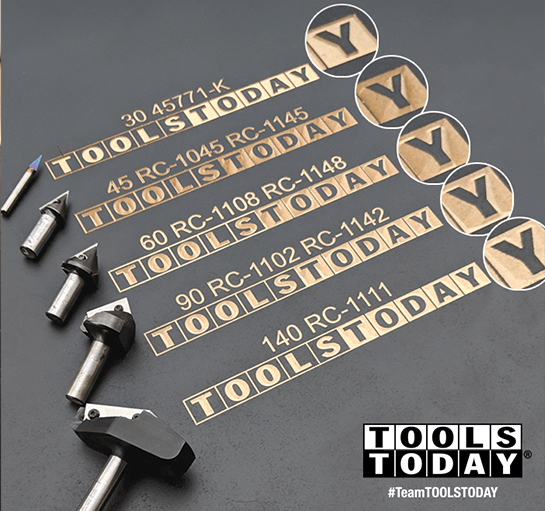
The Most Popular Router Bit Types for Woodworking
This article has been updated for 2025 here: 11 Router Bits Every Woodworker Should Own.
The list of top router-bit types is the same, but the 2025 list gets really granular by naming literally our most popular bits, like, which exact styles and sizes are among our top-sellers.
In this (2023) post, we delve into the most popular router bit types, providing insights into their distinct functionalities and applications. From the straightforward workhorse straight-plunge bit, to the intricate detailing of a Roman ogee bit, we’ll guide you through the essential bits that every DIYer should own.
Side note: for a really comprehensive list, check out our Router Bit Profiles Photo Glossary where we describe literally hundreds of different kinds of bits. Here we're going to concentrate on the most popular types - first with a quick list, then some details and pro-tips for using them.
Top-10 Router Bits for Woodworking
(Well. It's really the top-11 if you count straight-plunge and spiral-plunge as 2 different types. But they basically do the same thing.)
- Straight-Plunge Bit: This classic router bit is essential for making precise straight cuts in woodworking projects. It will cut a channel with straight sides and a flat bottom. It can be used for edge trimming as well as creating dadoes, grooves, and rabbets.
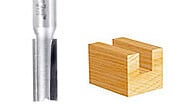
- Spiral-Plunge Router Bit: Similar to a straight-cutting bit, but the flutes wrap around the bit in a spiral. This allows better chip evacuation, as well as creating less vibration and tear-out. Spiral cutters come in up-cut, down-cut, and compression bits.

- Core Box Bit: The core box bit is used to create deep, round-bottomed grooves in woodworking projects, as opposed to the straight or spiral-plunge bits which make flat-bottomed grooves. It is perfect for making decorative fluting, grooves, or hollowing out areas for inlays.

- V-Groove Bit: The V-groove bit creates V-shaped grooves in the wood, giving it a decorative and architectural look. It is commonly used for sign making, lettering, and chamfered edges.
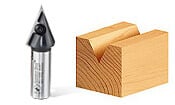
- Rabbeting Bit: Rabbeting bits are used to create recessed edges, also known as rabbets, in woodworking. They are commonly used for joining pieces of wood or creating decorative effects on the edges of shelves and panels.
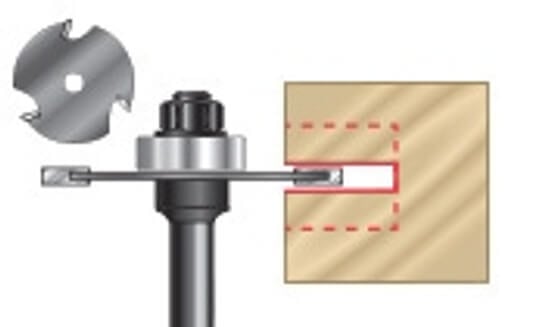
- Flush-Trim Bit: The flush-trim bit is used to remove excess material and trim edges flush with the surface. Essentially, it is a straight-cutting bit with a ball-bearing pilot which guides the cutter along the cutting path. It is perfect for trimming veneer, laminate, or other overhanging edges.
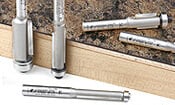
- Slot-Cutting Bit: Slot-cutting bits are used to create slots or channels in woodworking projects. They are ideal for making spline joints, biscuit holes, T-molding grooves, or for creating unique decorative effects.
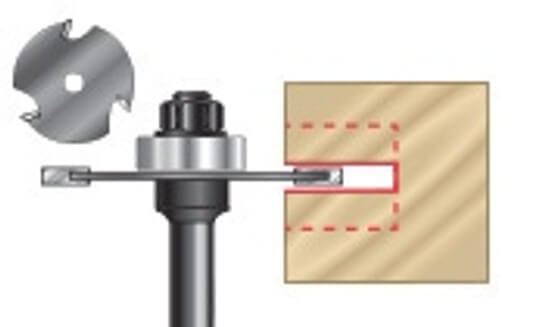
- Round-Over Bit: Also called a "corner-round," the round-over bit helps add smooth rounded edges to your woodwork, giving it a polished and decorative finish. It is commonly used on tabletops, cabinet doors, and furniture edges.

- 45-Degree Chamfer Bit: Chamfer bits create beveled edges at a 45-degree angle. They are commonly used for decorative purposes, such as adding a chamfer to tabletops, shelves, and cabinet edges.

- Cove Bit: The cove bit is used to create concave profiles in woodworking projects. It is ideal for making decorative grooves, fluting, or adding detail to table legs and columns.

- Ogee Bit: Ogee bits create an elegant S-shaped profile on the wood, adding a decorative touch. They are commonly used for creating moldings, picture frames, and furniture details.
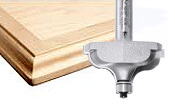
Router Bit Types: Details and Pro Tips

Straight Plunge Bit
A straight-plunge bit, also known as a straight-cutting router bit, is an essential tool in woodworking. It is designed to create precise straight cuts in wood. Here are three key points to know about this tool:
- Versatile: A straight-cutting bit can be used for a variety of applications, such as creating dadoes, rabbets, and grooves. Its straight profile allows for clean and accurate cuts.
- Material Compatibility: This bit is suitable for cutting through different types of wood, including hardwoods and softwoods. It is also effective for cutting materials like plywood and MDF.
- Size Options: Straight-cutting bits come in various sizes, allowing woodworkers to choose the right diameter and cutting depth for their specific projects. Always select one with the shortest cutting edges and the shortest overall length that will reach the required cut depth. Excessive length intensifies deflection and vibration, which degrade cut quality and lead to tool breakage.
Straight bits are easy to use and provide excellent results when used with a router. They offer precision and control, making them a valuable tool for woodworkers of all skill levels.

Spiral Plunge Bit
Spiral bits combine a shearing action in cutting, with an augering action in chip clearance. The shearing action yields an especially clean & accurate cut, while the augering action clears chips from the cut. The “up-cut” shears from the bottom up, pulling chips from the bottom up, thus allowing deeper penetration with less stress on the tool. The “down-cut” cuts from the surface down, leaving a smooth edge at the surface.
- The up cut action of the bit pulls the wood fibers up and out of the cut allowing for maximum chip evacuation; this will result in some frayed edges, typically easily cleaned up with a quick hit of sandpaper, or possibly chipout on the top surface of the material.
- Because the wood fibers are being pulled up this will result in a clean bottom edge of the cut, just like the clean top edge created by the downcut bit.
- More efficient chip evacuation leads to being able to run the bits at an increased feed rate, while reducing excess heat caused by recutting the same chips prolonging the life of your bit.

Core Box Router Bits
A core box bit is a type of router bit used in woodworking that creates rounded bottom grooves or decorative cavities in wood.
These bits feature a rounded tip that is ideal for creating smooth, rounded grooves, slots, and intricate carvings in both softwood and hardwood. The core-box bit's design includes fluted edges, which allow for efficient removal of material and help to minimize burning and improve the finish quality. Ideally carbide-tipped for durability, these bits come in various diameters, enabling precision and versatility in creating decorative details or functional features like channels for wiring or pipework.
Cut half-round grooves for fluted moldings, columns, millwork, and signs using a core box bit. Used with an edge guide, it can cut coves. It is perfect for juice groove in cutting boards.
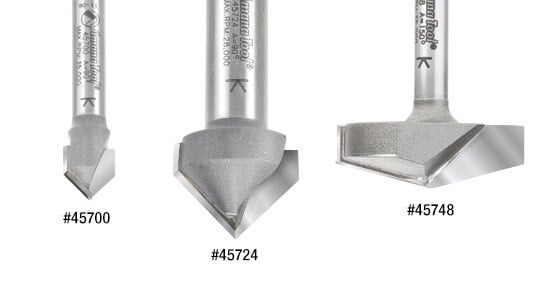
V-Groove Bit
A V-shaped grooving router bit, commonly known as a V-groove bit, is a specialized woodworking tool used to create decorative channels or grooves on wood surfaces. V-grooves with very small angles such as 30° are commonly used as engraving bits. Follow these steps to effectively use a V-groove bit:
- Choose the right size and type of V-groove bit for your project, considering the desired groove width and depth. 45° will handle the finest details, and 60° is a good general go-to bit.
- Secure the wood piece firmly using clamps or a suitable woodworking vise.
- Adjust the router's depth of cut to match the desired groove depth.
- Position the V-groove bit at the starting point of the groove, making sure it is aligned with the desired path.
- Slowly plunge the bit into the wood and guide it along the intended route, maintaining a steady pace.
Once the groove is complete, move the router along the remaining path to ensure a smooth and consistent groove.
See our article Degrees of a V-Groove.
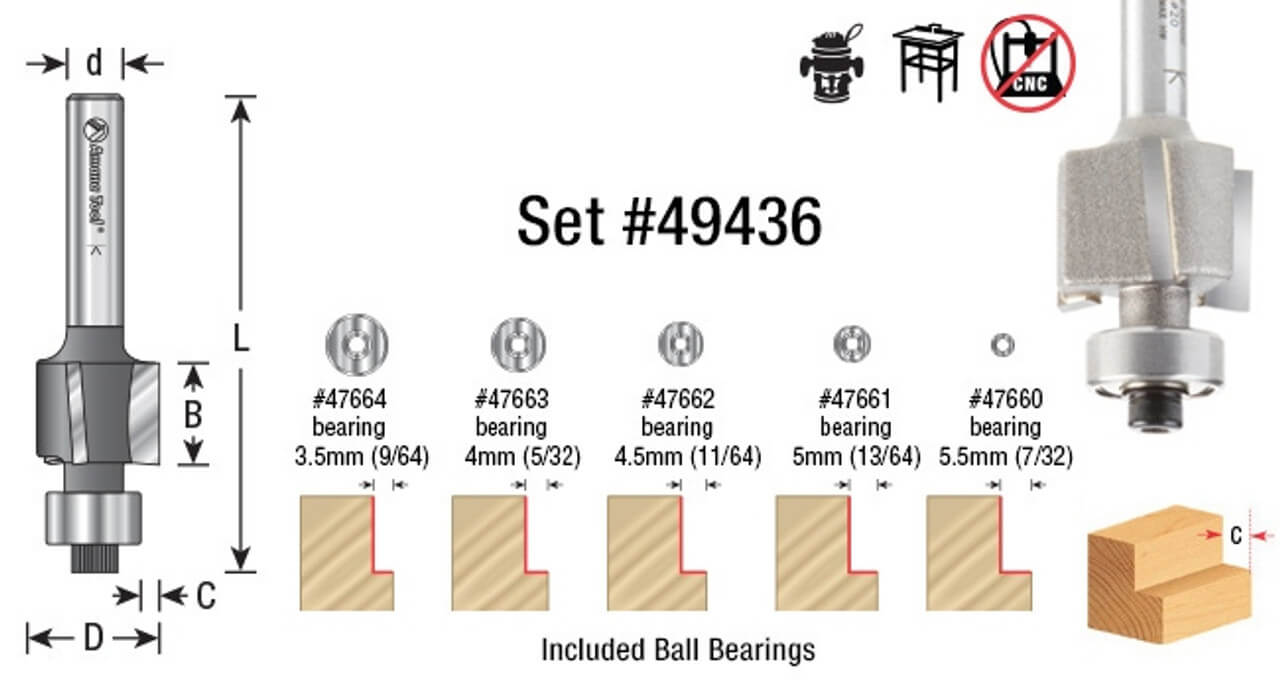
Rabbeting Bit
Like a Flush-Trim bit, a Rabbeting Bit uses a ball-bearing pilot to guide the cutting edge, to create a step-like recess called a rabbet on the edge or face of a wood material.
Unlike a Flush-Trim, the pilot is deliberately not the same diameter as the cutting edge. The difference creates the precise depth of the rabbet.
Key points about the Rabbeting Bit:
- Versatility: The pilot guides can be adjusted to create different depths and widths of rabbets, making this bit suitable for various woodworking projects.
- Efficient Material Removal: With its sharp cutting edges, the Rabbeting Bit quickly and efficiently removes wood to create precise and clean rabbet joints.
- Joinery Applications: Rabbet joints created by the Rabbeting Bit are commonly used for joining two pieces of wood together or for fitting in panels, glass, or other materials.
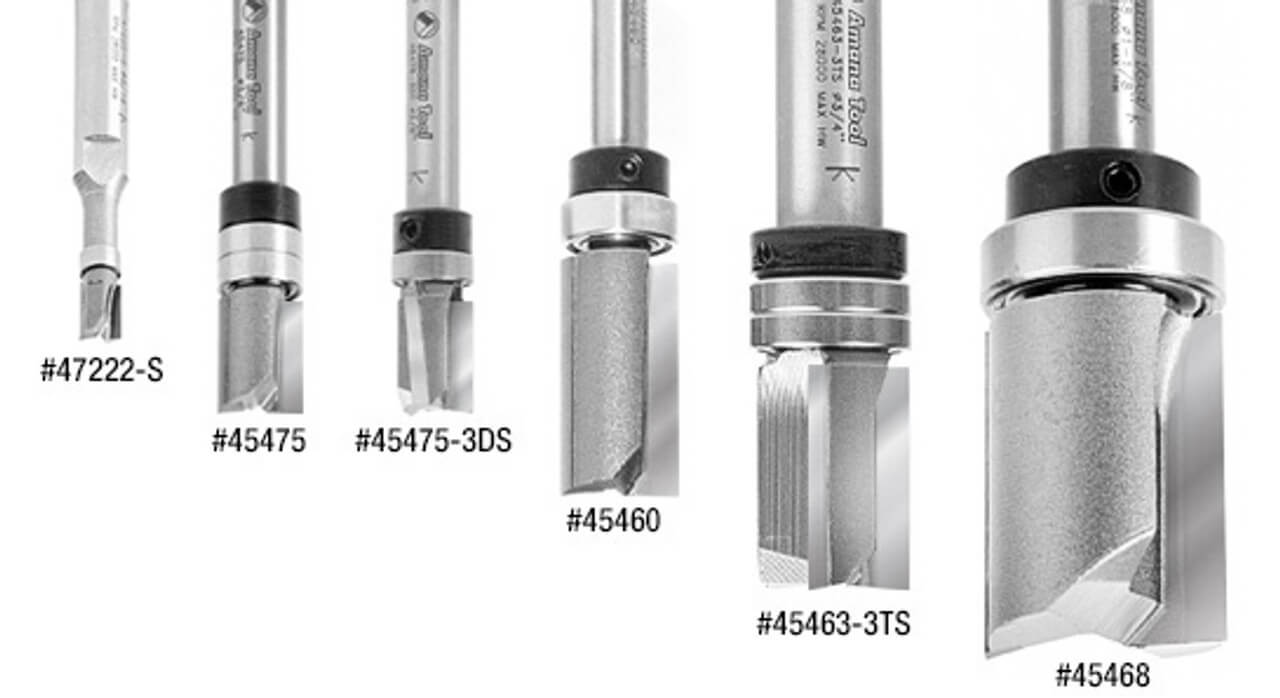
Flush-Trim Bit
A Flush-Trim Bit is a professional woodworking tool used to precisely trim the edges of any material to match the contour of another piece. It is commonly used for removing excess laminate flush with an underlying MDF substrate, or for precise copying of templates.
The Flush-Trim Bit is distinguished by its straight type design, with a ball-bearing pilot the exact diameter of the of the cutting blades, which guides the cutting edge exactly flush with the underlay material.
This versatile tool is essential for achieving precise and smooth finishing touches in woodworking projects.

Slot-Cutting Bit
A slot-cutting bit is widely used in woodworking for creating precise slots or grooves in various materials.
- Efficient Slot Cutting: The slot-cutting bit effortlessly cuts slots with consistent depth and width, allowing for precise joinery and decorative details in woodworking projects.
- Versatile Applications: This router bit is suitable for both handheld and table-mounted routers, and it can be used on different materials like wood, MDF, plywood, and even plastic.
- Adjustable Depth and Width: With its ability to adjust the cutting depth and width, the slot-cutting bit provides flexibility to accommodate various project requirements and desired outcomes.
- Clean and Smooth Cuts: The sharp cutting edges of the bit ensure clean and smooth slot cuts, minimizing the need for additional sanding or finishing work.
- Compatibility with Guide Systems: Slot-cutting bits are often compatible with guide systems, allowing for enhanced precision and control during the routing process.
Pro Tip: Using a slow and steady feed rate while operating the router can help achieve cleaner slot cuts with reduced chances of tear-out or splintering. Remember to always wear appropriate safety gear, such as goggles and ear protection, when working with any power tools.

Round-Over Bit
A round-over bit is a type of router bit that is used in woodworking to create rounded edges and contours on the surface of a piece of wood. It's probably the most commonly used type of profiling bit. It is often used to soften sharp corners and give a smoother finish to the wood.
- Round-over bit is perfect for creating decorative edges on furniture pieces or molding.
- It can be used on both hardwood and softwood.
- Round-over bit is available in different sizes, allowing for various radius options.
- This type of router bit creates a consistent and smooth curve on the wood.
- It is easy to use and can create a polished look with minimal effort.
- Round-over bit can be used on both hand-held routers and table-mounted routers.
Round-over bit is a versatile tool that can add a professional touch to woodworking projects. Whether you are creating custom furniture or adding finishing touches to a DIY project, a round-over bit can help achieve smooth and rounded edges.
Pro Tip: Before using a round-over bit, make sure to secure the wood properly to avoid any accidents or injuries. Always follow safety guidelines and wear appropriate protective gear when operating a router.

45-Degree Chamfer Bit
A 45-degree chamfer bit is a woodworking tool that is used to create a beveled edge at a 45-degree angle on a piece of wood. It is typically used to add decorative edges or to create a smooth transition between two surfaces.
- Creates a 45-degree beveled edge on wood
- Used for decorative edges or smooth transitions
- Can be used with a router to achieve precise cuts
- Available in various sizes and materials for different woodworking projects
This versatile tool provides woodworkers with the ability to add unique details to their projects, giving them a professional and polished look. It allows for precise and clean cuts, resulting in high-quality finished pieces.

Cove Bit
A Cove Bit, also known as a Cavity Drill, is a type of router bit used in woodworking to create concave grooves or decorative edges on wooden surfaces. It features a curved cutting edge that removes material as it rotates, resulting in a smooth and curved profile.
A Cove Bit can be identified by its design, which typically includes a cylindrical body with a concave cutting edge. It's like the opposite of a round-over bit.
It is available in various sizes and diameters to cater to different woodworking needs.
These measurements provide an understanding of the different sizes available for Cove Bits and their corresponding dimensions. It is important to select the appropriate size based on the desired groove or decorative edge width.
A Cove Bit is commonly used in woodworking projects such as creating ornamental moldings, picture frames, and decorative edges on furniture. It adds visual interest to the woodwork and can enhance the overall aesthetic appeal of the finished piece.
Pro Tip: When using a Cove Bit, it is recommended to start with a smaller diameter bit and gradually increase to larger sizes if necessary. This approach helps achieve cleaner and smoother cuts, minimizing the risk of tear-out or uneven edges. Always make sure to secure the wood properly and use appropriate safety measures when working with router bits.

Ogee Bit / Roman Ogee
Known for its elegant profile, the Ogee bit is a popular choice among woodworkers. It creates a decorative edge that adds a touch of sophistication to any woodworking project.
- The ogee is one of the basic shapes used in moldings and decorative profiles. An S-shaped curve, it is convex at the top fairing down into a concave.
- The ogee bit is characterized by the concave shape coming off the pilot bearing.
- The Roman ogee bit is the opposite. It has a convex curve coming off the bearing, and produces the reverse of the ogee (it isn't an upside-down ogee). The curve starts at the top as a concave, and fairs down into a convex curve.
- Sound confusing? Concave means indented, like a cove. (Think: cave.) Convex is like a roundover or bull-nose shape.
Read more in our article, What is an Ogee Router Bit?

Choosing the Right Router Bit Types
When you get your first router, the best way to explore is to get a small set with a variety of router bits, and see which ones you use over and over, and, what other bits you need to supplement your set. The general-purpose AMS-410 is an excellent choice.

One other note: Make sure you get the right shank size. While you can use a collet adapter to fit a 1/4" shank into a 1/2" machine, 1/2" shank bits are considerably stronger and provide a safer, smoother cut.
Smaller, handheld / trim routers typically typically accept only 1/4" shank. If that is your machine, opt for the AMS-134. You'll probably want to supplement with a flush-trim bit, but you won't have the power for a slot cutter.

FAQs about Top 10 Router Bit Types For Woodworking
What are the top 10 essential router bits for a DIYer?
Answer: The top 10 essential router bit types for a DIYer are straight- or spiral plunge bit, core box bit, v-groove bit, rabbeting bit, flush-trim bit, slot-cutting bit, round-over bit, 45-degree chamfer bit, cove bit, and the Roman ogee bit,
How can a straight-cutting bit be used in woodworking?
Answer: A straight-cutting bit is used to cut straight, square-bottomed grooves, such as rabbets, dadoes, and grooves for plywood cabinet backs and drawer bottoms.
What is the purpose of a round-over bit?
Answer: A round-over bit is used to round over sharp edges on shelves, tabletops, chair arms, and other woodworking projects, providing a decorative and safe finish.
What can be achieved with a Roman ogee bit?
Answer: A Roman ogee bit is used to create classical decorative detailing on the edges of tabletops, picture frames, vertical stiles, and horizontal rails, adding an elegant touch to woodworking projects.
How can a cove bit enhance furniture and cabinet doors?
Answer: A cove bit cuts a concave radius out of the edge, providing a decorative edge that enhances the appearance of furniture legs, cabinet doors, and bookshelves.
What is the application of a slot-cutting bit?
Answer: A slot-cutting bit is used to cut narrow slots or grooves in various woodworking projects like cabinet door frames, floorboards, picture frames, and drawer parts. It is also ideal for cutting spline grooves for spline joints.




